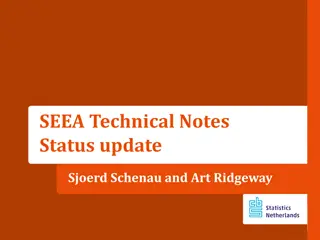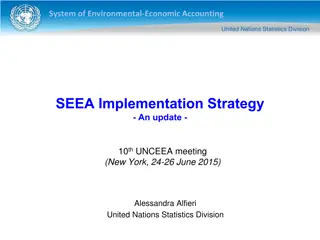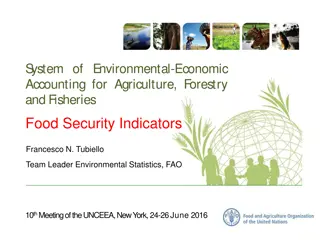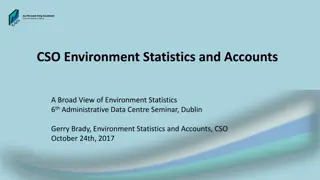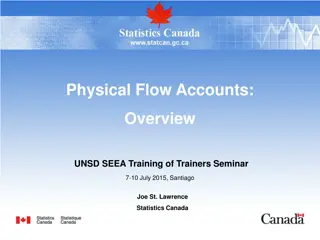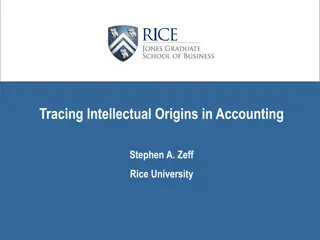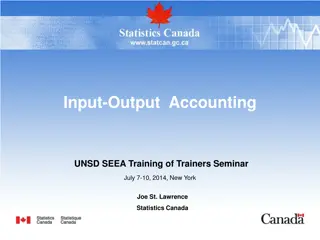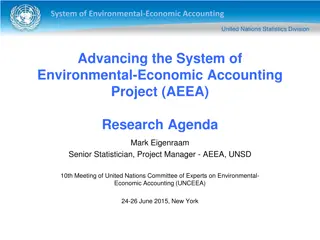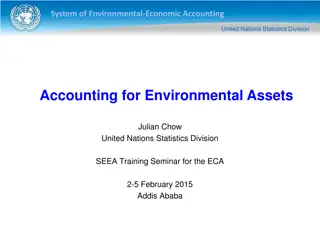Understanding the System of Environmental-Economic Accounting (SEEA)
The System of Environmental-Economic Accounting (SEEA) is a framework that combines economic and environmental data to offer a comprehensive view of the connection between the economy and the environment. It includes standard concepts, definitions, and classifications for producing internationally comparable statistics. The SEEA framework covers asset accounts, flow accounts, environmental activities, and ecosystem accounting, providing insights into the interaction between economic activities and natural resources.
- Environmental accounting
- SEEA framework
- Economic data integration
- Climate change statistics
- Sustainable development
Download Presentation

Please find below an Image/Link to download the presentation.
The content on the website is provided AS IS for your information and personal use only. It may not be sold, licensed, or shared on other websites without obtaining consent from the author. Download presentation by click this link. If you encounter any issues during the download, it is possible that the publisher has removed the file from their server.
E N D
Presentation Transcript
System of Environmental-Economic Accounting Session 3: Data collection, compilation of indicators and quality control National Workshop on Climate Change and Disaster-related Statistics Ekaterina Poleshchuk
The System of Environmental-Economic Accounting (SEEA) https://seea.un.org/ The System of Environmental-Economic Accounting (SEEA) is a framework that integrates economic and environmental data to provide a more comprehensive and multipurpose view of the interrelationships between the economy and the environment. It contains the internationally agreed standard concepts, definitions, classifications, accounting rules and tables for producing internationally comparable statistics and accounts. The SEEA framework follows a similar accounting structure as the System of National Accounts (SNA). 2
SEEA Central Framework (1/2) https://seea.un.org/content/seea-central-framework Assets accounts System of Environmental-Economic Accounting Central Framework (SEEA CF) adopted in 2012 Flow accounts provides tools for describing stocks and changes in stocks of environmental assets (water, land, energy, timber, etc.), as well as supporting environmental activities Environmental activity accounts 3
SEEA Central Framework (2/2) https://seea.un.org/content/seea-central-framework Flow AccountsDescribe the flows of accounts and energy accounts. Asset AccountsMeasure the quantity and Encompass those economic activities whose primary purpose is to reduce or eliminate pressures on the environment or to make more efficient use of natural resources. Environmental Activity materials and energy that come: - from the environment to the economy, - are used in the economy, and - pass as residuals from the economy to the environment. value of environmental assets and record changes in those assets over time. Consider the following environmental assets: mineral and energy resources, land, soil resources, timber resources, aquatic resources, other biological resources, and water resources. Cover environmental protection expenditure, environmental goods and services, environmental taxes and subsidies, permits and licenses to use environmental assets. Can be presented as material flows accounts, water 4
SEEA Ecosystem Accounting (1/2) https://seea.un.org/ecosystem-accounting Ecosystem extent accounts System of Environmental-Economic Accounting Ecosystem Accounting (SEEA EA) Ecosystem condition accounts adopted in 2021 takes a spatial approach to accounting which identifies the location and size of ecosystem assets, the ecosystem services provided, and the location of beneficiaries Ecosystem services accounts 5
SEEA Ecosystem Accounting (2/2) https://seea.un.org/ecosystem-accounting AccountsTake a spatial approach to accounting - Ecosystem extent accounts record the total area of each ecosystem (terrestrial, freshwater and marine ecosystems). - Ecosystem condition accounts measure the quality of an ecosystem measured in terms of its abiotic and biotic characteristics and how they have changed. -Ecosystem services: providing, regulating, cultural. As described in Chapter 13 of the SEEA EA: -Ecosystem extent accounts can be linked to emissions from land use, land use change and forestry (LULUCF). -Condition accounts provide information on carbon storage in ecosystems, such as soil organic carbon and dry matter productivity. -Ecosystem services accounts can also provide information on global climate regulation ecosystem services. With focus on Climate Ecosystem Change which identifies the location and size of ecosystem assets and the ecosystem services provided. 6
Global Assessment of Environmental-Economic Accounting https://seea.un.org/content/global-assessment-environmental-economic-accounting The Global Assessment of Environmental- Economic Accounting and Supporting Statistics is a survey, provided by UN Statistics Division Aim: to assess the progress of implementation of the SEEA in countries Results are available online: Country-by-country detailed results Report on the global assessment of SEEA 7
SEEA in different formats (2/2) Indicators of economic pressure on the environment, 2019 (billion tons) 9
SEEA development at the national level 1. Preliminary Analysis: of legislative, institutional and methodological bases of international experience Investigation : of data available in national institutions responsible for data collection of data available in international databases Implementation: of environmental-economic accounts Publication 4. Publication 3. 2. Implementation 2. Investigation 3. 1. Preliminary Analysis 4. Timeline: 2-3 years 10
Thank you Ekaterina Poleshchuk Statistician, SDG and Environment Statistics Unit Early Warning and Assessment Division ekaterina.poleshchuk@un.org www.unep.org United Nations Avenue, Gigiri PO Box 30552 00100 GPO Nairobi, Kenya


